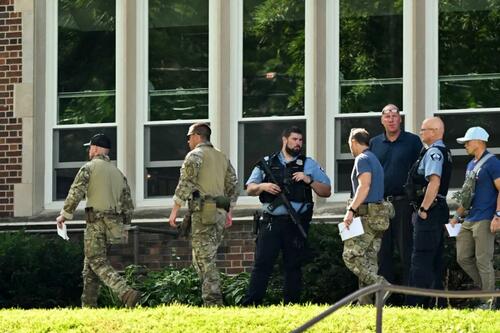Authored by Michael Clements via The Epoch Times (emphasis ours),
A Pennsylvania school district is using artificial intelligence to keep guns off its campuses. But civil liberties advocates have warned that the technology could lead to mass surveillance and violation of constitutional rights.

The Chartiers Valley School District in Allegheny County has implemented AI that harnesses the district’s Wi-Fi signals to determine whether people are carrying weapons as they enter the schools.
The technology, called Wi-AI, was developed by CurvePoint of Pittsburgh. CurvePoint grew out of AI research at Carnegie Mellon University.
According to the company, Wi-AI uses “spatial intelligence” to find weapons such as guns before they enter a school.
The AI system analyzes a space and detects where potential weapons are located by interpreting “how Wi-Fi signals reflect off people and objects.”
Once a possible weapon is found, security personnel, school administrators, or others can go to the location to determine whether there is actually a threat.
It is now in use at Chartiers Valley School District high school, middle school, and primary school campuses. CurvePoint CEO Skip Smith said that in a recent test, the system found a pistol hidden in a backpack. He said the technology has a 95 percent success rate, failing only 4 percent of its searches.
Smith said the Wi-AI does not carry the same privacy concerns of other security systems because it does not rely on facial recognition or biometric data.
“We don’t know it’s you,“ Smith told The Epoch Times. ”We have no biometric information about you. Our system just sees a big bag of salt water.”
Darren Mariano, president of the Chartiers Valley Board of School Directors, said the district is excited to be the first in the country to adopt the technology.
“The safety of our students and staff is always our top priority,” he said in a statement. “We’re thrilled to be the first district in the nation to implement this groundbreaking technology.”

But some say the technology should be approached with caution.
Jeremy Rovinsky is a constitutional law professor at Crestpoint University in Phoenix. He said the Constitution’s Fourth Amendment protections against unlawful search and seizure apply to public school students, although the standard is slightly different in a school setting.
Under the Fourth Amendment, a government official must have probable cause to believe that a crime is being committed before obtaining a search warrant.
However, in New Jersey v. T.L.O., the Supreme Court ruled that a school administrator needed to have only a “reasonable suspicion” that the search would turn up evidence of a crime.
In that case, a teacher reported that two students had been smoking in a girls restroom.
One of the 14-year-olds denied the allegation. An administrator searched the girl’s purse and found cigarettes, what appeared to be marijuana, paraphernalia for smoking marijuana, and evidence that she was selling pot to her classmates.
The student was found to be delinquent in juvenile court. She appealed the decision on the grounds that the search was illegal.
The high court ruled that the administrator had a reasonable suspicion for the search based on the teacher’s report and that a search warrant was not required.
In a message to The Epoch Times, Rovinsky said the law also recognizes “administrative searches.” These are non-intrusive, general searches that are targeted to preventing a specific danger such as keeping guns out of school.
Still, Rovinsky wrote, new technology should be introduced carefully to ensure that it does not become a constitutional problem.
“While school authorities have greater latitude to search students and their possessions than authorities outside of school, the scope of what counts as reasonable imposes limits on school searches,” Rovinsky wrote.
Seattle-based lawyer Evan Oshan said the technology could devolve into allowing warrantless searches of every person to enter the campus based on no evidence or reasonable suspicion.
If not checked, according to Oshan, the technology could be implemented in all public spaces, creating an even larger surveillance state.

“We’re normalizing constant surveillance of our children under the guise of safety,” Oshan wrote in a message to The Epoch Times. “This dragnet approach sweeps up everyone, guilty and innocent alike, which is precisely what the Fourth Amendment was designed to prevent.”
Smith agreed that the technology will grow. However, he said, growth will provide more benefits than risks.
He said the technology can be used to monitor the elderly or those with dementia, or to provide security and marketing data by tracking for business.
“Our view of the future is we’re offering inferences on how spaces are being used ... but without capturing, you know, private information on who the individual [user] is,” he said.
He acknowledged that AI is a relatively new technology and that some glitches may arise. But he said that as the Wi-AI learns, the company will prioritize privacy and security.
Oshan’s view is not quite as rosy.
“This technology creates a slippery slope,“ he said. ”Today it’s Wi-Fi signals searching for weapons in schools. Tomorrow it’s on public transportation, in shopping malls, at government buildings. Where does it end? The Constitution provides the guardrails, and we ignore them at our peril.”
Loading recommendations...